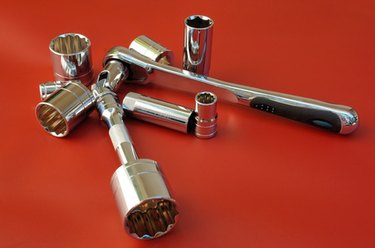Things You'll Need
Craftsman ratchet repair kit
Pry tool or pocket knife
Needle-nose pliers

A ratchet handle and socket set, such as the Sears Craftsman 1/2-inch ratchet set, is used for home and automotive projects. Unlike a traditional, open-end wrench, a ratchet handle with the correct-sized socket will allow you to quickly tighten or loosen a bolt by simply pumping your wrist. Ratchets rarely break, but if they do, it's often a failure of the spring-loaded ball inside the ratchet's socket mount that is used to hold sockets in place.
Step 1
Purchase a Craftsman repair kit that is compatible with a 1/2-inch Craftsman ratchet handle. These kits can be purchased at tool stores or online.
Video of the Day
Step 2
Pry off the cover on the rear of the ratchet head with a pry tool or a pocket knife blade. This will expose the inner workings of the ratchet.
Step 3
Remove the ratchet's circular spring connector with the needle-nose pliers. Insert each jaw of the pliers into the holes at either end of the spring connector ring, then squeeze until the ring pops out of the ratchet's head. One the spring connector is removed, pull the ratchet head assembly out of the ratchet head.
Step 4
Replace the broken part of the ratchet with the corresponding piece from the ratchet repair kit. The repair kit contains a replacement piece for each working part of the ratchet. If the ball inside the socket mount has failed, replace it. If the ratcheting wheel has failed, replace it.
Step 5
Put the inner workings of the ratchet back into the ratchet head and test the ratchet to make sure it works. Using the needle-nose pliers, snap the spring connector back into place. Press the rear cover back into place.
Tip
Contact your nearest Craftsman dealer to determine if your ratchet handle has a lifetime warranty, as many Craftsman products do. If so, return the ratchet to the dealer and get a new one free of charge.
Video of the Day